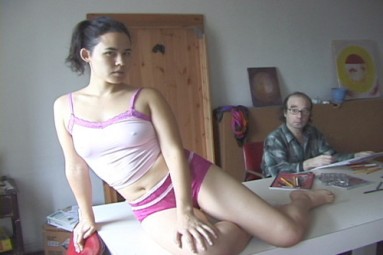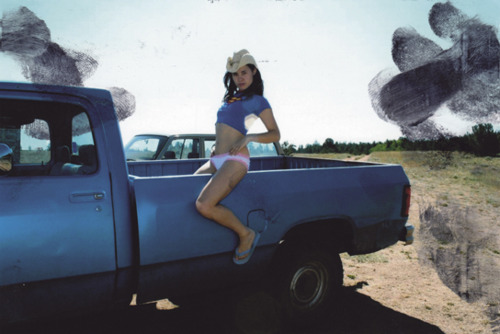But the point of all this self-exploitation may be to make us sick of looking at her. In a 2006 interview with The Believer, Nakadate claimed her work, in part, was about “the ridiculousness of showing up anywhere and thinking anyone will give you attention.” It’s ridiculous because attention, in the world she delineates, always costs something. The retrospective suggests what her cumulative strategy has been for translating this idea into visceral feeling: She seems to want to exhaust us with a series of conniving demands for attention that, to be aesthetically effective, must exceed what we’re already willing to devote when we go to see art. Only then will we be pushed into acknowledging the place Nakadate seems to want to reach, where the integrity of how you feel about yourself, the possibility of recognizing the sincerity of your own emotions, is sacrificed to the need to be looked at — and not even necessarily with approval. It comes slowly into focus that one is never more lonely than when bathed in attention and that to escape loneliness would require not more attention but a willful annihilation. Her search for this place, for the identity-dissolving end point of attention seeking, is what makes her work so disturbing.
Nakadate is known mainly for her videos that have her cavorting on camera with dumpy male co-stars, quintessential lonely schlumps, typical and eternal strangers who agree to let her film them in their houses. These are men who appear to have made peace with obscurity, whose appetite for social recognition has dwindled to the vanishing point — the sort of men so ubiquitous yet so rarely represented in media that their appearances in these videos seem uncanny. Nakadate fosters a fragile, potentially volatile connection with them, trusting that resignation, passivity, and impenetrable solitude constitute the natural horizons of their existence, no matter how sexually confrontational she becomes with them. In the videos, she often seems blatantly patronizing, projecting the notion that she’s graciously agreed to bring some beauty and creativity into these men’s cramped little existences.
Oops!, one of the earliest pieces in the show, establishes many of Nakadate’s recurring ideas. In three separate videos that run concurrently, Nakadate performs the music-video choreography from Britney Spears’s “Oops! I Did It Again” — a faux-coy song about “accidental” seduction (“Oops, I played with your heart”) that turns on the phrase “I’m not that innocent” — in the kitchen or living room of a middle-aged sad sack while the song plays on a boom box (a Hello Kitty boom box, she takes care to stipulate on the wall card). In each video, the man is on screen with her: One of them stands grimly still and stares ahead; the other two try to improvise and join in with her dancing while she performs her scripted moves undeterred. She is present but wholly inaccessible, smiling at the camera and ensconced in the ritual, while the men are gulled by the seductive, improbable promise of someone young and beautiful descending into the muted squalor of their presumably lonely and long-since-sexless lives.
We are confronted with evidence of a certain kind of youthful femininity’s power, and the particular sort of man it tends to have power over. Using the sort of power that brought Britney fame necessarily calls forth objects suitable to its dominion, transforming men into the sort of sketchy, leering creeps it requires to be effective. Another of Nakadate’s video pieces, I Want to Be the One Who Walks in the Sun, pushes this logic further, juxtaposing scenes of her flirting with men who fit this stereotype with one in which a dog repeatedly humps her leg as she dances around in French-maid lingerie.
Capitalizing on that power to make men into sexually frustrated beasts ultimately means trapping oneself in a world that includes only their sort — a realm of existential abandonment that Nakadate repeatedly evokes in her work with images of canopies at open-all-night gas stations, of efficiently bland motel rooms, deserted city streets, tractor-trailer parking lots, the haunted glow of strings of streetlights at night. Viewed from outside, these locales are poignantly evocative, even seductive; like all the networks that infiltrate and structure our everyday life, they promise to administer to our solipsism and cater to our convenience. But at the same time, they make up a vast infrastructure of loneliness and disconnection. When you are in such environments, these feelings are inescapable, and trying to reach out to others can only seem absurdly out of character, if not ominously disruptive.

By putting herself in these environments, by selecting this type of man as her muse, Nakadate posits an equivalence between herself and them that seems cruel because it is so unlikely, so obviously belied by the testimony before our eyes. The stark emotional reality of their lives seems self-evident, and Nakadate is pushing to uncover their secret, how they’ve managed to live with anonymity, in a truce with loneliness. Her beauty and vivacity seem to disqualify her from real feelings of loneliness and reconciliation with them, no matter how much time she spends in the netherworld of male mediocrity, or no matter how hard she feigns sadness for her photographs. The most recent work in the show, the photo series 365 Days: A Catalogue of Tears, is a tableaux of sexualized sadness staged to document her effort to “deliberately take part in sadness each day.” The possibility of spontaneous feeling is banished from the scene in advance, a concession to the inescapable truth about pointing a camera at yourself. Instead Nakadate presents a reliquary of stylized sadness, of traditional poses borrowed from art history and redeployed in bathrooms, motel rooms, and Gregory Crewdson-ish setups. Her confidence that this contrived, commodified emotion will find its patrons provides the genuine sadness that underlies the fake.
In Nakadate’s work, art ceases to be an alibi for looking. Instead, it’s a pretense for unleashing voyeurism and exhibitionism, for opening negotiations over the more primal matter of who’s paying attention to whom and what it should cost. This is most obvious in a video piece called Lessons 1-10, which purports to be a montage of scenes from a series of Sundays Nakadate spent posing for a slovenly balding man who advertised for an artist’s model on Craigslist. As Patsy Cline sings “You Belong to Me” (ironic deployment of melodramatic schmaltz is another of her hallmarks), Nakadate stares back at us through the camera while the artist tries to capture her in his sketch pad. Her deadpan expression as she sprawls topless on a table or dons kitsch Geisha gear conveys a knowing scorn; as we watch, we partake in the artist’s rationalization. There’s no way to look without mirroring his prurient gaze. This doubling recruits the audience as unwilling co-conspirators. In Nakadate’s world, increasingly our world, there are only exhibitionists and voyeurs. No other points of contact exist.

Given such a world, both the desperate attention seeker and the lonely attention giver are consigned to read from the same dismal script that emerges from their symbiosis. Beautiful Places to Hide a Body or Make Art (Romance) dramatizes this explicitly. In this piece, Nakadate feeds lurid lines about herself to a croaking old man, who dutifully repeats them over footage of Hollywood alleys and apartment complexes. It feels like an effort to assert mastery over an obscurely traumatic event through compulsive repetition. Most of the echoed lines are leering commands — “Let me look at you,” “Show me your panties,” etc. — but the most insistent and threatening of them is a question: “You know you’re pretty, right?” The statement comes up again in Good Morning Sunshine, a sequence of three films in which Nakadate stages pervert home invasions, issuing similar orders to a silent and demurely obedient teenage girl in her bedroom. She directs each girl to take off items of clothing while zooming in on their flesh, simulating a stereotypical male gaze. “You know you’re the prettiest girl, right?” But what she really seems to be asking is, What does it mean to agree to that when it no longer matters who is asking? Is that indiscriminateness how one comes to deserve attention? The girls offer no resistance, show no sign of wanting some other kind of recognition. They patiently abide their objectification as if it were utterly beside the point. Their bodies are present, but the attention has sent them elsewhere.
